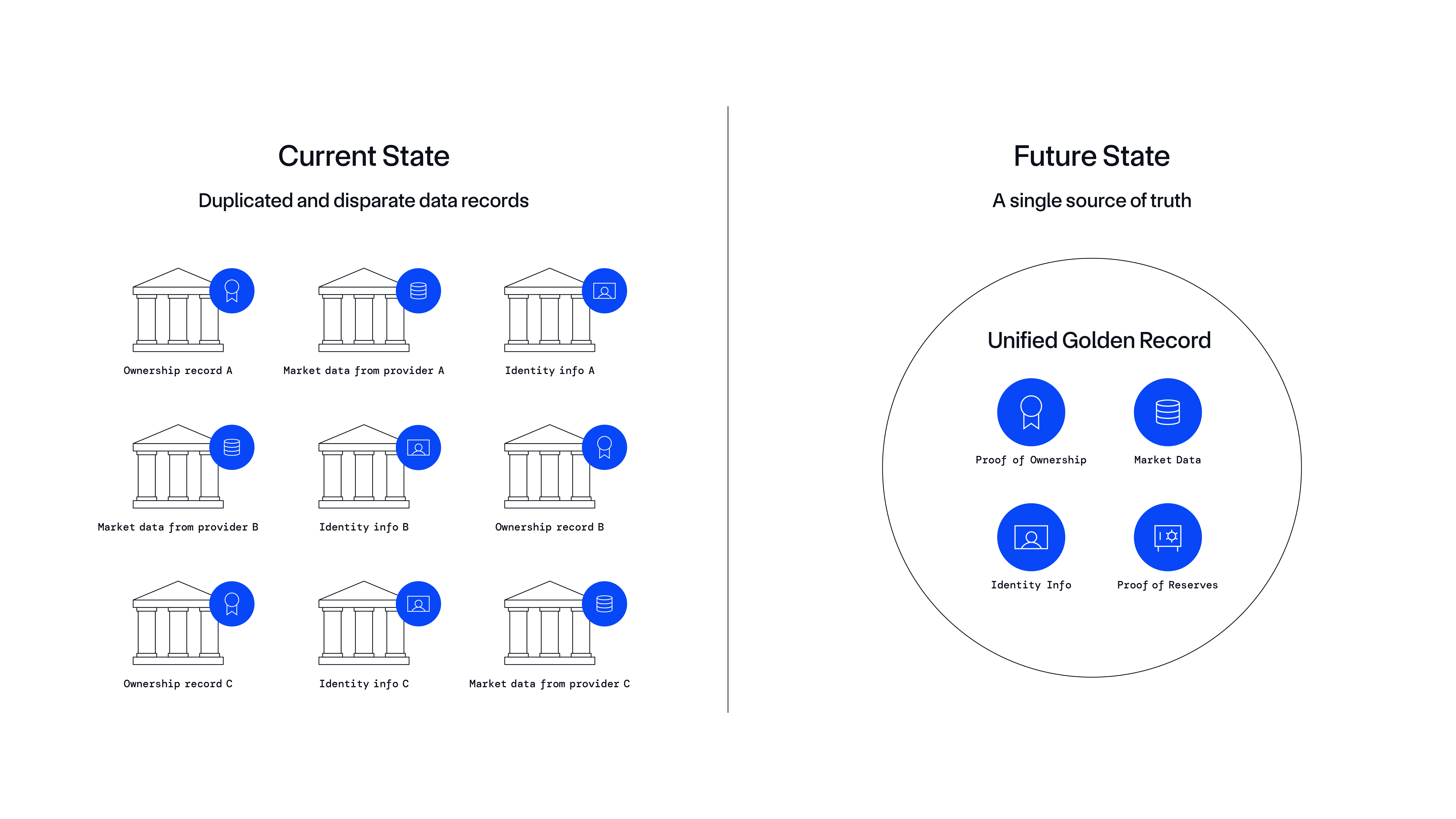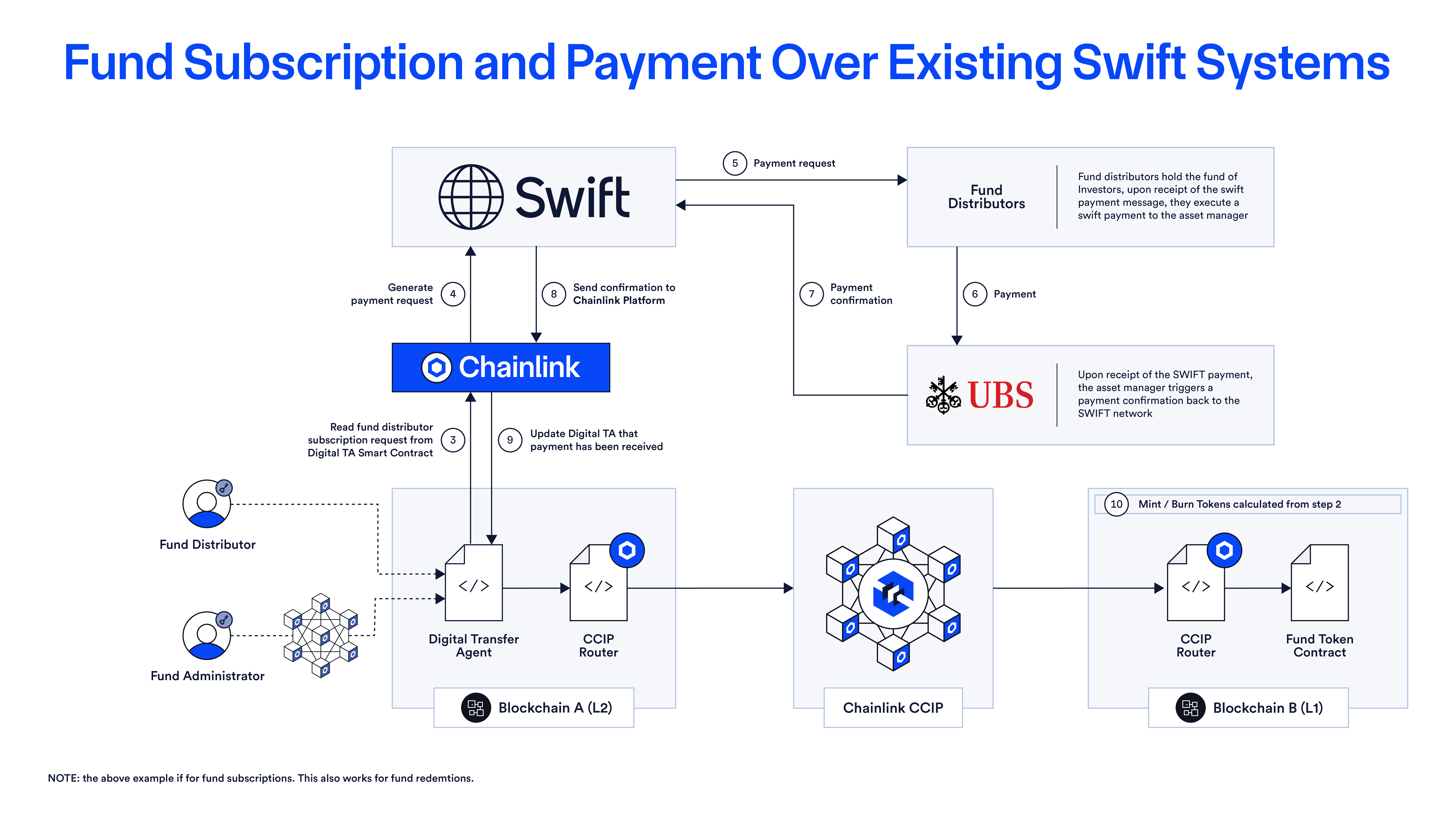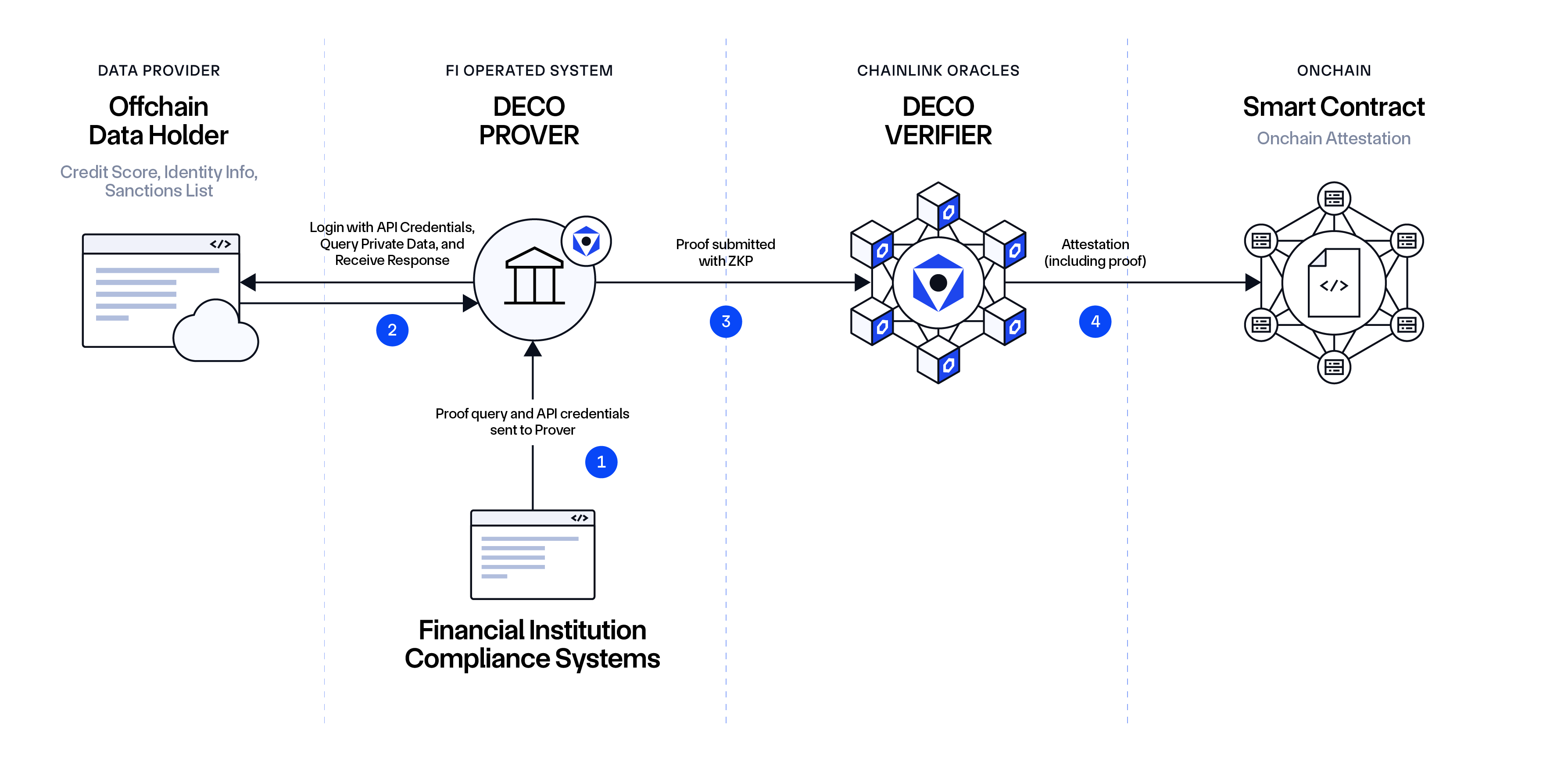How Transfer Agency Requirements Are Met With Blockchain Infrastructure
On May 15, 2025, the SEC published interpretive guidance that recognizes public‑blockchain infrastructure as a viable foundation for registered transfer agents. The guidance draws heavily on the technical recommendations Chainlink Labs submitted across six in-depth briefings with Staff since March 2025.
During these sessions with the SEC’s Crypto Task Force, including Commissioner Peirce, as well as the Division of Trading & Markets, Chainlink Labs presented proposed interpretive guidance, an analysis of existing transfer agent rules, and demonstrations of how the blockchain can be a viable record, with smart contracts enabling transfer‑restriction enforcement while preserving investor privacy.
Below, we recap the three unanswered questions we helped resolve and reproduce the key diagrams that resonated most with regulators.
Three Core Questions for Blockchain-Based Transfer Agency
Based on input from the SEC, three foundational questions have emerged that determine whether blockchain infrastructure can support transfer agency functions within the current regulatory framework.
1. Can Blockchains Serve As an Onchain Golden Record for Recordkeeping?
Transfer agents are responsible for maintaining detailed records of securities ownership. This includes recording the identity of each securityholder, the quantity and class of securities held, among other important details. These records must be accurate, updated promptly, retained over time for auditing purposes, and made accessible to authorized parties such as regulators, issuers, and other market participants.
Some registered investment advisors (RIAs) and transfer agents have started using blockchains to create what are often referred to as “digital twins” of these records. A digital twin in this context is an onchain representation of a security’s ownership history that mirrors the data kept in traditional offchain record management systems. These blockchain-based copies are used for transparency or marketing purposes but are rarely treated as the authoritative record.
This duplication reflects an ongoing question in the industry: can an onchain ledger itself serve as the primary recordkeeping system, not just a courtesy copy or digital twin?
This position was formally acknowledged in the recent SEC staff guidance, which stated that a blockchain ledger can serve as the official master securityholder file for a registered transfer agent, provided the surrounding requirements are satisfied. The guidance also confirmed that transfer agents using distributed ledger technology do not need to maintain a separate offchain “digital twin,” validating the onchain model described here.
2. Can Smart Contracts Be Used to Safeguard Assets and Enforce Transferability?
Transfer agents are responsible for safeguarding the securities they administer and ensuring that asset lifecycle events occur only under the appropriate conditions. This includes both safeguarding the asset itself and enforcing restrictions tied to the financial instrument, such as investor eligibility, holding periods, jurisdictional limitations, or other regulatory requirements.
In traditional systems, these responsibilities are typically managed through internal controls, policies, and operational processes that determine whether and when an asset can be transferred. In a tokenized environment, the structure of that control changes. Rather than relying on offchain decision points, transfer conditions can be encoded directly into the smart contracts that govern the asset.
This raises the question of whether programmable enforcement can fulfill the same oversight function expected of transfer agents. Can a rules-based system embedded onchain ensure that assets remain secure and compliant throughout their lifecycle?
3. Can Transfer Agents Meet Privacy Obligations on Public Blockchains?
Transfer agents are responsible for protecting investor data, particularly nonpublic personal information (NPI) such as names, addresses, account numbers, and transaction history linked to individual identities. These obligations are rooted in financial privacy regulations that require financial institutions to prevent the unauthorized disclosure of sensitive customer information.
Public blockchains present a unique challenge in this context. While they provide transparency and auditability, they also make wallet addresses and transaction histories visible to anyone. Without careful design, this visibility could create privacy risks, especially if wallet activity can be linked to specific investors.
To address this, many tokenized asset platforms have opted to operate on permissioned blockchains where data exposure can be more tightly controlled. Others have avoided certain public infrastructure altogether. The key question is whether transfer agents can fulfill their privacy obligations while using public blockchains, and if so, how onchain activity can be structured to keep NPI protected.
How Blockchain Infrastructure Answers These Three Core Questions
1. How Blockchains Can Meet Transfer Agent Recordkeeping Standards
The regulatory requirements related to the maintenance of ownership records include expectations for durable storage, prompt and accurate posting of ownership changes, and verifiable authorization for transactional events such as subscriptions or redemptions. While these expectations were developed originally involving paper securities certificates and gradually evolved to accommodate electronic processes, they do not prescribe a particular technology. The relevant question is whether a blockchain-based ledger can satisfy the same operational and compliance standards as existing market practices involving paper and, more recently, electronic server-hosted record management systems.
Transfer agents are permitted to use electronic systems as long as they retain records in a tamper-evident format, make them readily accessible for review, and maintain copies, among other requirements. A blockchain ledger can satisfy these conditions with proper implementation. Transactions are recorded immutably across a distributed network, ensuring long-term data integrity. The ledger is replicated across multiple nodes, providing redundancy by default. Blockchain records can also be formatted to meet examiner access requirements, including the ability to retrieve, review, and reproduce ownership data on demand.

Ownership records must also be updated accurately and without delay. Since blockchain systems achieve settlement finality in near real time, changes in ownership are recorded as they occur. This eliminates delays associated with batch posting or manual reconciliation and ensures the record reflects the current state at all times.
A further requirement is that asset transfers be properly authorized. In a blockchain-based system, transactions are signed using private keys and may be linked to external compliance controls. These digital signatures provide a verifiable trail of authority and control that can meet or exceed what is expected in traditional processes.
The blockchain ledger itself is what satisfies the core recordkeeping obligation. It is the source of record. However, operating that record in a live, multi-party environment—across systems, chains, and jurisdictions—requires more than a ledger alone. That is where the Onchain Golden Record applies.
The Onchain Golden Record is an architectural layer built around the blockchain record. It enriches the onchain ledger with key reference data such as NAV, compliance status, or legal ownership conditions. It also synchronizes with other onchain or offchain sources such as identity or audit systems. This structure allows transfer agents and other institutions to treat the blockchain ledger not just as a passive store of ownership data, but as an operational record that supports live processes, automated workflows, and real-time regulatory oversight.

Rather than maintaining duplicative records in offchain databases, the UGR allows all participants to work from a common source of truth. Ownership history, permissions, and status can all be managed in one composable, verifiable, and continuously updated record. This is not a departure from what current standards require. It is a more direct and transparent way of fulfilling those requirements using blockchain infrastructure.
2. How Smart Contracts Can Be Used for Transferability Enforcement
Transfer agents are required to maintain control over the securities they administer, including the ability to prevent unauthorized transfers. Smart contracts can enforce transferability controls by requiring that specific conditions be met before a transaction is approved. These conditions can include restrictive legends, transfer instructions, investor eligibility, jurisdictional compliance, lock-up periods, or other restrictions configured by the transfer agent. If the requirements are not satisfied, the transaction is prevented from executing, without the need for manual review or intervention.
Transfer agents today can implement a range of onchain controls that closely reflect the functions they perform in traditional environments. Smart contracts can restrict transfers to whitelisted wallets, apply time-based or geographic limits, and include administrative functions such as freezing, revoking, or reassigning tokens. These functions are gated behind role-based permissions, ensuring that only authorized parties can access or modify enforcement logic. Wallets can also be linked to verified investor identities through registries that combine onchain addresses with offchain KYC or accreditation status.
One implementation that demonstrates this functionality in a live setting was completed by Chainlink, SBI Digital Markets, and UBS Asset Management under the Monetary Authority of Singapore (MAS) Project Guardian initiative. As part of a production implementation for tokenized fund issuance, the project deployed a digital transfer agent smart contract that enforced key compliance requirements throughout the fund lifecycle. This contract governed investor subscriptions, NAV validation, and eligibility checks. Once an investor met all requirements and payment was confirmed through Swift, the smart contract issued tokenized shares directly to the eligible wallet. At no point did the transfer agent need to hold private keys or manually approve transfers. The smart contract maintained full control over asset movement based on preconfigured conditions.

An additional implementation done under the Project Guardian initiative involving Swift, UBS Asset Management, and Chainlink extended this control model by integrating fiat payment settlement into the process. Subscriptions and redemptions for tokenized fund shares were executed using the Swift network, enabling the payment leg of the transaction to be settled offchain in fiat while still being governed by smart contract logic onchain. This demonstrated how transfer agents can maintain control over the full lifecycle of a tokenized asset using systems that bridge traditional finance and blockchain infrastructure. The result is straight-through processing of fund transactions without sacrificing regulatory control or oversight.

Smart contract-based enforcement offers a compliant and operationally sound alternative to traditional models of asset safeguarding. It preserves the principle that transfer agents must retain authority over the securities they administer, while improving transparency, auditability, and execution speed.
3. How Investor Privacy Can be Preserved on Public Blockchains
Transfer agents are required to safeguard investors’ nonpublic personal information (NPI), including any data that can be used to identify an individual investor, such as names, addresses, account numbers, and transaction history when linked to a known identity. The question for blockchain-based systems is whether public visibility of wallet addresses compromises that obligation, even if the identity data itself is not made public.
Public blockchains are by design transparent, but that transparency can be scoped. A properly architected system separates the ownership record from the underlying identity data. The Onchain Golden Record architecture does exactly this: while the tokenized asset and its transaction history are visible onchain, the personal data associated with the wallet is stored offchain and only accessible to parties who are authorized to process that data in accordance with privacy laws.
This separation ensures that no personal data is published onchain, and wallet addresses cannot be readily used to identify specific individuals without access to the corresponding offchain registry. As a result, the blockchain itself does not become a source of NPI.
Privacy-preserving technologies help support this model. For example, cryptographic techniques such as zero-knowledge proofs as utilized by solutions like Chainlink DECO allow investors to prove compliance status (such as KYC or accreditation) without disclosing any personal information. These systems help maintain investor confidentiality while enabling real-time compliance checks within the onchain workflow.

Transfer agents retain full control over investor data, access to sensitive information remains tightly permissioned, and public blockchain infrastructure can be used without compromising privacy obligations. By keeping NPI offchain and tightly gated, tokenized securities platforms can meet financial privacy requirements while operating transparently and efficiently across public networks.
Conclusion
Public blockchains, smart contracts, oracles, and privacy-preserving infrastructure can support a broad range of responsibilities required of transfer agents under existing regulations. Blockchain ledgers can serve as the official source of record, while smart contracts can enforce transferability controls that meet asset safeguarding standards. Sensitive investor data can remain offchain while still being verifiably linked to onchain activity through cryptographic proofs.
We applaud initial steps taken by the SEC to recognize that blockchain is a technology format that can satisfy regulatory requirements. The regulatory standards are already in place. Aligning them with modern infrastructure would give market participants the clarity to move to fully operational, compliant tokenized markets on public blockchains.
